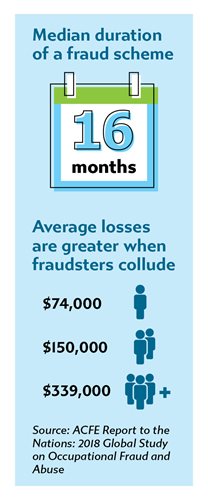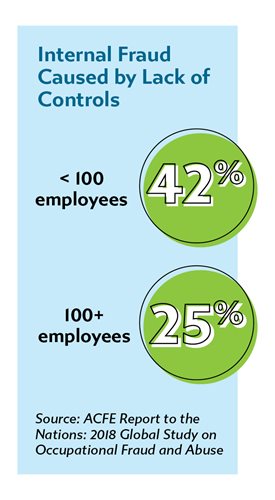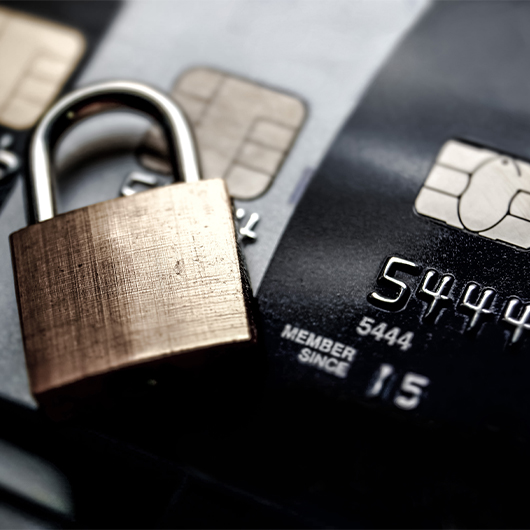The Dangers of Internal Fraud
The Dangers of Internal Fraud
When you run a business, you want to believe that no one on your team would ever consider stealing from the company. Unfortunately, circumstances sometimes cause good people to make bad decisions. Think about the financial pressure on an employee whose spouse or child has mounting out-of-pocket medical bills, or whose credit card debt has gotten out of control. The opportunity to steal funds from the company may be too tempting to resist. Over time, the cumulative effects of such behavior can harm and even ruin a business.Of course, there are more nefarious types of behaviors to watch out for as well. Either way, companies need to be wary of internal, or occupational, fraud. Through its Report to the Nations: 2018 Global Study on Occupational Fraud and Abuse, the Association of Certified Fraud Examiners (ACFE) revealed that, while companies of all sizes are targeted by internal fraud, businesses with 100 or fewer employees lose almost twice as much per fraud incident, with a median loss of $200,000, as larger companies, with a median loss of $104,000. That’s because fraud tends to go undetected longer in smaller companies due to inadequate control measures.
Following are some common types of occupational fraud and control measures that may help you mitigate the risk of this internal threat.
 5 Common Types of Internal Fraud
5 Common Types of Internal Fraud
Asset Misappropriation
Asset misappropriation is the most common type of internal fraud. It includes a broad range of schemes aimed at stealing company assets. Here are some of the more prevalent ones:
- Check tampering: An employee with access to company checks made out to vendors or other payees alters the name and/or amount, or forges the signature on checks so that they can cash them.
- Cash theft: Retail businesses that handle a lot of cash can be especially hard hit by cash theft as an employee may steal cash outright or skim — pocketing the cash without ringing up the sale.
- Payroll fraud: Stealing from the company’s payroll system happens a number of ways: An employee may ask a peer to punch the time clock when they are not working, a payroll clerk may create a fake (ghost) employee record and have those paychecks deposited into their own account, an employee may collude with a payroll clerk to temporarily raise their hourly rate, etc.
- Expense and commission fraud: An employee with an expense account might submit illegitimate reimbursement claims, possibly including forged receipts. Likewise, a sales rep might falsify sales records to collect larger commissions than are warranted by actual sales.
Vendor Fraud
An employee with knowledge of their company’s payment procedures may work solo or with a vendor to commit fraud. For example, they may submit invoices for fictitious goods or services, requesting payment to a personal or shell company bank account, or they may submit invoices from an established vendor but provide fraudulent payment instructions so payment goes directly into their own accounts. In collusion, a vendor might pad invoices so that the employee gets a kickback, perhaps for some favor fulfilled.
Accounting Fraud

Employees with access to the company’s books may intentionally misrepresent or alter the company’s sales, revenues and expense records to cover crimes such as embezzlement and schemes targeting the accounts payable and receivable processes.
Data Theft
Employees most often commit data theft as they are leaving their company, illegally using or sharing confidential data such as trade secrets, client lists or personally identifiable information stored in the company’s data system.
Corruption
Senior-level executives can cause not only financial damage but also reputational damage when they abuse their power for personal or business gain. Bribery, kickbacks, corporate tax evasion and money laundering all fall under this category of internal fraud.
Tips for Protecting Your Business
One of the reasons smaller businesses are more vulnerable to internal fraud is that they often lack internal controls for deterring these actions. Following is a checklist of controls to consider putting into place.
Financial Moves
- Conduct a fraud risk assessment with your banker, accountant or other trusted advisers to evaluate your potential exposure.
- Monitor your bank statements electronically for real-time transparency, looking for any unusual changes or activity.
- Use remote deposit to minimize or eliminate the flow of paper checks from your office.
- Set spending limits on corporate credit cards and be specific about what constitutes a legitimate credit card purchase.
- Review your financial statements at least quarterly, with a discerning eye for irregularities.
 HR Measures
HR Measures
- Conduct thorough background checks on new hires.
- Draw up and distribute a code of conduct sharing expectations of ethical behavior.
- Restrict access to confidential and proprietary information.
- Conduct frequent management reviews to keep track of departmental or group activities.
- Segregate duties so no one person has end-to-end control over any aspect of your company’s finances.
- Make sure all of your employees take scheduled vacations. Knowing someone else will have access to their files and documents may deter bad behaviors.
- Conduct anti-fraud training regularly so your team knows you watch for these behaviors.
- Set up a hotline for employees to report fraudulent behavior confidentially.
Download a copy of this whitepaper.
Our treasury management experts are here to help. If you'd like to discuss solutions for your business, call 1-855-282-3888, Monday - Friday from 8:30 AM - 5:00 PM.
This article is for general information purposes only and is not intended to provide legal, tax, accounting or financial advice. Any reliance on the information herein is solely and exclusively at your own risk and you are urged to do your own independent research. To the extent information herein references an outside resource or Internet site, Dollar Bank is not responsible for information, products or services obtained from outside sources and Dollar Bank will not be liable for any damages that may result from your access to outside resources. As always, please consult your own counsel, accountant, or other advisor regarding your specific situation.
Posted: July 07, 2021




